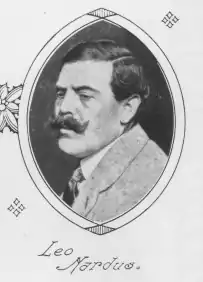Leonardus Nardus
Leonardus Nardus (5 May 1868 – 12 June 1955) was a Dutch fencer,[1] impressionist painter and art collector of Jewish origin whose considerable collection was looted by the Nazis.[2] He won a bronze medal in the team épée event at the 1912 Summer Olympics.[3] Nardus had connections to the chess world as well.[4]
 | |||||||||||||||
| Personal information | |||||||||||||||
|---|---|---|---|---|---|---|---|---|---|---|---|---|---|---|---|
| Nationality | Dutch | ||||||||||||||
| Born | 5 May 1868 Utrecht, Netherlands | ||||||||||||||
| Died | 12 June 1955 (aged 87) Tunisia | ||||||||||||||
| Sport | |||||||||||||||
| Sport | Fencing, chess | ||||||||||||||
Medal record
| |||||||||||||||
During the 1890s and early 1900s Nardus gained an alarming reputation for his work as an art dealer in the United States, operating primarily out of New York and Philadelphia. Nardus swindled American millionaires such as Peter Arrell Brown Widener by selling for extraordinarily high prices relatively worthless pictures as landmarks of Western Art, under what Widener later described in a distraught personal letter as “gross false pretenses.” [5] Nardus was unmasked as a swindler in 1908 by the art connoisseurs Cornelis Hofstede de Groot, Bernard Berenson, Wilhelm Valentiner and Roger Fry, but the incident was kept (mostly) quiet at the time because Nardus’s wealthy clients, including J.P. Morgan and the influential Philadelphia corporation lawyer John G. Johnson, feared embarrassment of the Emperor’s New Clothes variety. Likewise Nardus had, in any event, fled to Europe and never returned to face any consequences in America.[6] Although tantalizing rumors have long swirled about this matter in the Dutch, French and German literature on the history of art collecting,[7] the full story has only recently been reconstructed in a scholarly article published in the UK art journal Apollo in 2007.[8]
Art collection and looting by Nazis
In addition to being a world class athlete, Nardus was an important art collector. His collection included Rembrandt, Vermeer, Hals, Rubens, Botticelli, Goya, Turner, and Vélasquez among others.[9]
Nardus left his art collection, estimated at 150-160 artworks, with a friend for safekeeping. However, the collection was seized by the Nazis, because Nardus and the friend whose name was Arnold van Buuren were Jewish.[10] Van Buuren, was deported along with his wife to Sobibor and perished on 23 April 1943.[11]
Botticelli's Mary and the Child, John the Baptist and an angel, seized in 1942, was recognized as Nazi loot and restituted to Nardus' descendants in 2014.[12]
A Rubens that had been looted from Nardus was discovered in Bonn in 2014.[13] Most of the paintings have not been recovered.
References
- "Leonardus Nardus". Olympedia. Retrieved 21 May 2021.
- "Esse: il traque les oeuvres spoliées par les nazis". CharenteLibre.fr (in French). Retrieved 29 January 2021.
- "Leonardus Nardus Olympic Results". sports-reference.com. Archived from the original on 18 April 2020. Retrieved 14 April 2010.
- "Léonardus Nardus" by Edward Winter
- "Jonathan Lopez, "Gross False Pretences: The Misdeeds of Art Dealer Leo Nardus," in Apollo: The International Magazine of the Arts 347 (December 2007): 79-86". Scribd.com. 1 May 2021. Retrieved 1 May 2021.
- ”Gross False Pretences,” 83
- Wilhelm Martin, Alt-Holländische Bilder, Berlin (1918):18; H.E. van Gelder, Levensbericht van Dr. C. Hofstede de Groot, Leiden (1931):17; René Gimpel, Journal de un Collectioneur, Paris (1963):entry for 12 June 1918 - all cited in “Gross False Pretences,” 82.
- "Gross False Pretences,” 79-86.
- Bozec, Daniel (18 January 2015). "L'ex-banquier, Goering et les 160 tableaux de maître". SudOuest.fr (in French). Retrieved 30 January 2021.
- "Nardus Collection". www.van-ham.com. Retrieved 30 January 2021.
Formerly the precious tondo of Mary was part of the extensive Jewish collection Nardus. In 1940 the German Revision and Trust registered this painting and more than 150 other art objects as "property of the enemy" and finally the Nazis confiscated it in 1942
- "Nardus | Restitutiecommissie". www.restitutiecommissie.nl. Retrieved 30 January 2021.
- "Botticelli in Cologne Auction". www.lootedart.com. Looted Art. Retrieved 30 January 2021.
- "Un Rubens volé par les nazis à la famille Nardus enfin retrouvé à Bonn". Franceinfo (in French). 2 November 2014. Retrieved 30 January 2021.
External links
 Media related to Leo Nardus at Wikimedia Commons
Media related to Leo Nardus at Wikimedia Commons- Leo Nardus at Chessgames.com
- Leo Nardus at Olympedia